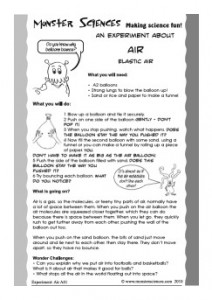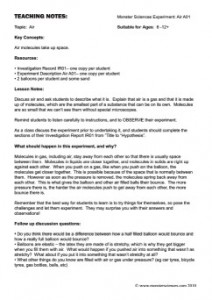Air Science Experiment Elastic Air – Your students will use 2 balloons and some sand to investigate how air exerts pressure.
 |
 |
Do you know why balloons bounce?An Experiment about Air: Elastic Air
What you will need:
• 2 balloons
• Strong lungs to blow the balloon up!
• Sand or rice and paper to make a funnel
What you will do:
- Blow up a balloon and tie it securely.
- Push on one side of the balloon gently – don’t pop it!
- When you stop pushing, watch what happens. Does the balloon stay the way you pushed it?
- Now fill the second balloon with some sand, using a funnel or you can make a funnel by rolling up a piece of paper. You don’t have to make it as big as the air balloon!
- Push the side of the balloon filled with sand. Does this balloon stay the way you pushed it?
- Try bouncing each balloon. What do you notice?
What is going on?
Air is a gas, so the molecules, or teeny tiny parts of air, normally have a lot of space between them. When you push on the air balloon the air molecules are squeezed closer together, which they can do because there is space between them. When you let go, they quickly rush to get further away from each other, pushing the wall of the balloon out too.
When you push on the sand balloon, the bits of sand just move
around and lie next to each other, then stay there. They don’t move apart, so they have no bounce.
Monster Challenges:
• Can you explain why we put air into footballs and basketballs? What is it about air that makes it good for balls?
• What stops all the air in the world floating out into space?
TEACHING NOTES:
Topic:
Air
Key Concepts:
Air molecules take up space.
Resources:
• Investigation Record IR01– one copy per student
• Experiment Description Air A01– one copy per student
• 2 balloons per student and some sand
Lesson Notes:
Discuss air and ask students to describe what it is. Explain that air is a gas and that it is made up of molecules, which are the smallest part of a substance that can be on its own. Molecules are so small that we can’t see them without special microscopes.
Remind students to listen carefully to instructions, and to OBSERVE their experiment.
As a class discuss the experiment prior to undertaking it, and students should complete the sections of their Investigation Report IR01 from “Title” to “Hypothesis”.
What should happen in this experiment, and why?
Molecules in gas, including air, stay away from each other so that there is usually space between them. Molecules in liquids are closer together, and molecules in solids are right up against each other. When you push on a gas, like when you push on the balloon, the molecules get closer together. This is possible because of the space that is normally between them. However as soon as the pressure is removed, the molecules spring back away from each other. This is what gives the balloon and other air filled balls their bounce. The more pressure there is, the harder the air molecules push to get away from each other, the more bounce there is.
Remember that the best way for students to learn is to try things for themselves, so pose the challenges and let them experiment. They may surprise you with their answers and observations!
Follow up discussion questions:
• Do you think there would be a difference between how a half filled balloon would bounce and
how a really full balloon would bounce?
• Balloons are elastic – the latex they are made of is stretchy, which is why they get bigger when you fill them with air. What would happen if you pushed air into something that wasn’t as
stretchy? What about if you put it into something that wasn’t stretchy at all?
• What other things do you know are filled with air or gas under pressure? (eg car tyres, bicycle tyres, gas bottles, balls, etc)
© www.monstersciences.com



